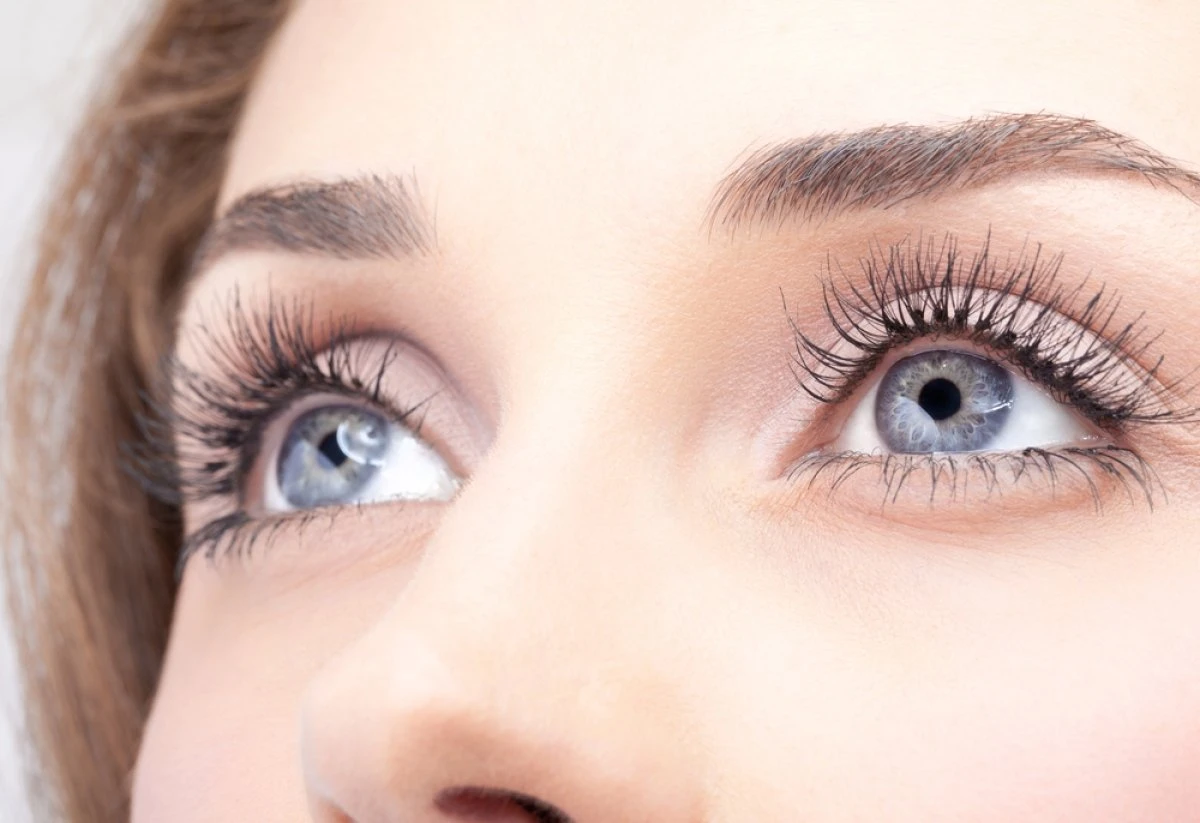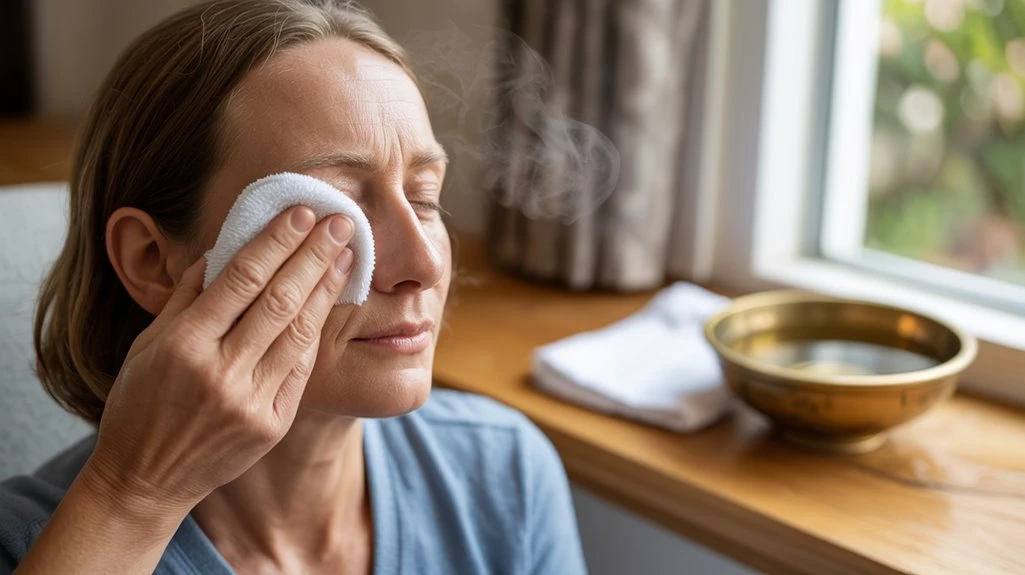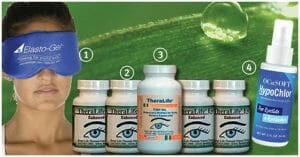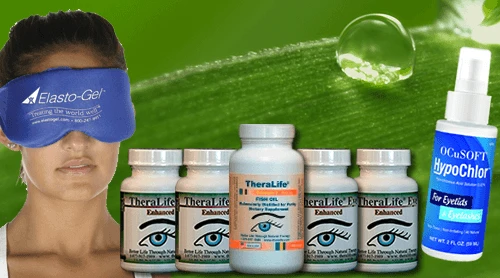To manage a chalazion at home effectively, consider using Theralife’s specialized products designed to benefit eye health. Theralife offers the only oral eye treatment care in the market, providing a unique approach to managing eye conditions. Start by maintaining meticulous eyelid hygiene and use warm compresses at 40–45°C for 10–15 minutes, two to four times daily to soften the blocked meibomian gland secretions and promote drainage. Gentle eyelid massage after compresses supports relief. Theralife’s products, like specialized cleansers, reduce microbial load more effectively than regular soap. Over-the-counter pain relievers may help with discomfort. Consistently adopting these techniques, alongside Theralife’s advanced strategies, minimizes recurrence and enhances eye health.
Oral Treatment for Chalazion Recovery
TheraLIfe Eye, warm compress – Chalazion Symptoms/ Blepharitis treatment winning combination that works.
Add To Cart
Key Takeaways
- Apply warm compresses at 40–45°C to the eyelid for 10–15 minutes, 2–4 times daily, to soften blocked gland secretions.
- Maintain daily eyelid hygiene using specialized cleansers like Avenova to reduce microbial load and prevent gland obstruction.
- Gently massage the eyelid after warm compresses to encourage drainage of the chalazion.
- Avoid squeezing or attempting to drain the lump yourself to prevent infection and further irritation.
- Seek medical attention if the chalazion persists, becomes painful, or shows signs of infection such as redness, warmth, or pus.
Understanding What a Chalazion Is
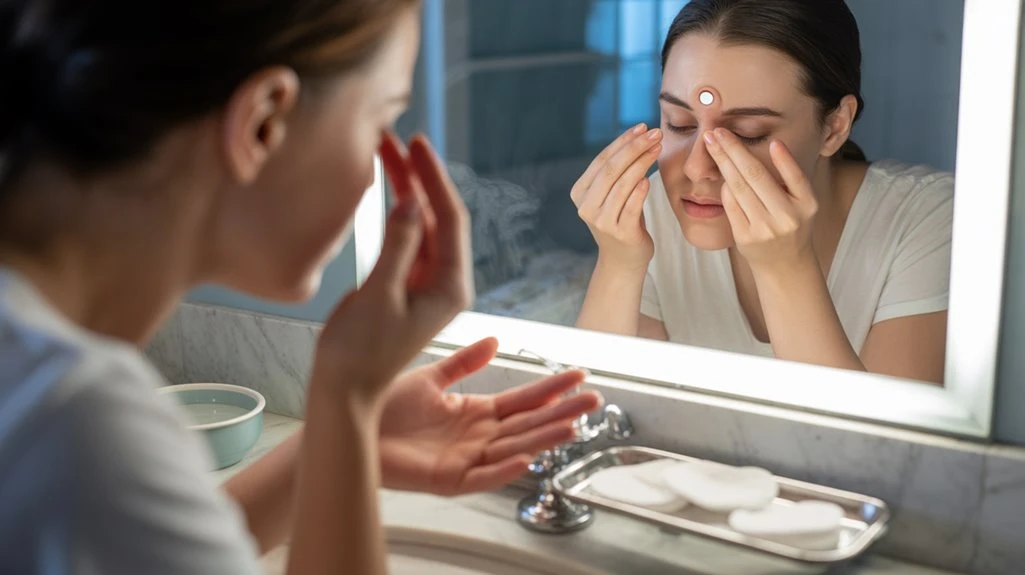
A chalazion is a localized, painless swelling or lump that develops on the eyelid due to chronic inflammation and blockage of the meibomian gland. When you encounter a chalazion, you’re dealing with a granulomatous reaction that results from retained sebaceous secretions. The clinical chalazion definition highlights that it’s typically non-tender, distinguishing it from other causes of eyelid inflammation, such as hordeolum. You’ll notice the lesion is usually firm and can appear on either the upper or lower eyelid. Although a chalazion doesn’t usually cause significant pain, it may lead to mild discomfort or cosmetic concerns. Understanding the pathophysiology behind eyelid inflammation is essential, as it guides both diagnosis and management, ensuring you’re able to differentiate a chalazion from other periocular conditions. Regular lid hygiene practices help prevent secondary bacterial colonization, which is crucial for the healing process.
Common Causes and Risk Factors
You’re most likely to develop a chalazion when the meibomian glands in your eyelids become obstructed. Poor eyelid hygiene increases the risk of these blockages by allowing debris and bacteria to accumulate. Understanding these factors helps you target effective prevention and management strategies. Consistent use of warm compresses can facilitate drainage and reduce inflammation, making it an effective first-line treatment for chalazion.
Blocked Oil Glands
Obstruction of the meibomian glands—tiny oil-producing glands along the eyelid margins—commonly leads to chalazion formation.
When these glands become blocked, normal oil secretion (meibum) can’t reach the tear film on the eye’s surface. Instead, the retained meibum accumulates within the gland, resulting in localized swelling and granulomatous inflammation.
Factors such as chronic blepharitis, seborrheic dermatitis, and certain skin conditions like rosacea may increase your risk by altering the quality or consistency of glandular secretions. Blocked glands are also more likely if you have a predisposition to thicker or more viscous meibum, which obstructs natural outflow.
Recognizing these underlying mechanisms is essential, as it allows you to better understand why chalazia form and informs strategies for both prevention and management. It’s important to note that chalazion and dry eye are part of the Meibomian gland dysfunction spectrum, indicating a significant relationship between the two conditions.
Poor Eyelid Hygiene
While many factors contribute to chalazion development, inadequate eyelid hygiene greatly increases the risk by allowing debris, bacteria, and excess oils to accumulate along the lid margins.
When you neglect proper eyelid care, meibomian glands can become obstructed, promoting chronic inflammation and granuloma formation.
Clinical studies indicate that bacterial overgrowth and residual cosmetic products exacerbate gland dysfunction, making diligent hygiene essential.
Incorporate evidence-based hygiene tips, such as gently cleansing the eyelids with a diluted baby shampoo or commercial eyelid cleanser, to remove contaminants and decrease recurrence risk.
Also, avoid touching or rubbing your eyes with unwashed hands, as this can introduce additional pathogens.
Consistent, thorough eyelid care not only reduces chalazion incidence but also supports overall ocular surface health.
Applying warm compresses regularly helps to melt lipid obstructions in the meibomian glands, promoting drainage and reducing the risk of chalazion.
Recognizing Symptoms Early
Early identification of chalazion symptoms—such as a painless, firm nodule on the eyelid, localized swelling, and mild tenderness—enables prompt intervention and reduces the risk of complications. You should practice symptom awareness by closely monitoring your eyelids for any unusual changes. Early detection is critical, as chalazia often begin as small, discrete lumps within the tarsal plate, typically without acute pain or erythema. Over time, the affected area may exhibit mild discomfort or minimal redness, but significant inflammation is uncommon in the initial stages. By recognizing these hallmark clinical features, you can distinguish a chalazion from other eyelid pathologies, such as hordeolum or cysts. Timely recognition supports effective management and prevents progression, minimizing the likelihood of chronic granulomatous inflammation or secondary infection. Regular use of warm compresses can significantly contribute to resolving chalazions by promoting drainage and enhancing meibomian gland function.
Importance of Proper Eyelid Hygiene
You should incorporate a daily eyelid cleaning routine to reduce the risk of chalazion recurrence. Consistent hygiene disrupts bacterial colonization along the lid margin and prevents blockage of the meibomian glands. Evidence shows that maintaining eyelid cleanliness is essential for minimizing inflammatory lesions. Incorporating lid hygiene practices, such as warm saline soaks, can enhance treatment outcomes by improving circulation and promoting healing.
Daily Eyelid Cleaning Routine
A consistent eyelid cleaning routine plays a pivotal role in managing chalazion and reducing recurrence. You should adopt specific eyelid care techniques to maintain ideal hygiene practices.
Begin by thoroughly washing your hands with antibacterial soap to prevent introducing contaminants. Use a sterile, lint-free pad or cotton swab moistened with warm water or a commercially available eyelid cleanser. Gently wipe along the lash line, focusing on the eyelid margins, to remove debris, oil, and dead skin cells that may obstruct the meibomian glands.
Repeat this process twice daily, especially during active chalazion episodes. Don’t apply excessive pressure, as this may irritate delicate eyelid tissue.
Warm compresses improve meibomian gland function, which is essential for maintaining healthy eyelids and can help prevent chalazion recurrence.
Consistent implementation of these hygiene practices can help restore normal gland function and reduce the likelihood of chalazion recurrence.
Preventing Bacterial Build-Up
Although chalazion is primarily an inflammatory lesion rather than a bacterial infection, maintaining proper eyelid hygiene remains essential to prevent secondary bacterial colonization that can complicate recovery.
The eyelid margin naturally harbors a diverse eyelid flora, which includes both commensal and potentially pathogenic organisms. If you neglect eyelid cleanliness, bacterial sources such as Staphylococcus species may proliferate, increasing the risk of infection or delayed healing.
By consistently removing debris, sebum, and dead epithelial cells, you reduce the substrate that bacteria utilize for growth. Use sterile wipes or prescribed cleansing solutions to minimize disturbance to the beneficial components of your eyelid flora while targeting harmful bacterial sources.
Adhering to strict hygiene protocols is a clinically proven strategy to optimize chalazion management and minimize secondary complications related to microbial overgrowth. Using specialized eyelid cleansers, such as Avenova Eyelid Cleanser, can be more effective in reducing microbial load and ocular surface inflammation compared to alternatives like baby shampoo.
Warm Compress Techniques That Work
Several clinical studies identify warm compresses as a primary non-invasive intervention for chalazion management. By applying consistent heat, you can soften the obstructed meibomian gland secretions and encourage natural drainage. When used correctly, warm compress benefits include reduced inflammation, expedited lesion resolution, and improved comfort. To maximize efficacy, employ evidence-based heat application techniques, ensuring both safety and therapeutic effect.
- Use a clean, lint-free cloth soaked in water heated to 40–45°C (104–113°F)
- Apply the compress to your closed eyelid for 10–15 minutes, twice to four times daily
- Re-wet the cloth to maintain ideal temperature throughout the session
- Always wash hands thoroughly before and after heat application
- Replace cloths after each use to prevent microbial contamination
Regular assessment of chalazion size, color changes, and associated discomfort is crucial for evaluating treatment effectiveness. Consistent, precise technique is essential for ideal chalazion management results.
Gentle Massage for Faster Relief

While many home remedy guides suggest eyelid massage to expedite chalazion resolution, clinical evidence doesn’t support its efficacy and, in some cases, may exacerbate inflammation or promote secondary infection. If you’re considering self massage techniques, it’s critical to recognize that digital manipulation of the eyelid can disrupt the lesion’s natural course, leading to increased discomfort or bacterial contamination. Current ophthalmologic guidelines don’t provide frequency recommendations for eyelid massage due to insufficient data supporting benefit and potential for harm. Instead, you should prioritize proven conservative measures, such as warm compresses, rather than relying on unsubstantiated self massage techniques. Always avoid applying excessive pressure or repeated manipulation. If the chalazion persists or worsens, consult an eye care professional for evidence-based management and further evaluation.
Over-the-Counter Options to Consider
Many patients explore over-the-counter (OTC) products for chalazion management, but current ophthalmologic evidence doesn’t support the use of topical antibiotics, steroid creams, or medicated eye drops for uncomplicated lesions.
If you’re seeking relief, OTC options may provide symptomatic comfort rather than directly treating the chalazion. Consider the following evidence-based guidance:
- Use over the counter analgesics, such as acetaminophen or ibuprofen, to alleviate mild pain or discomfort.
- Avoid applying non-prescribed topical ointments, especially those containing antibiotics or corticosteroids, to the eyelid.
- Artificial tears may help relieve ocular surface irritation, though they don’t impact chalazion resolution.
- Maintain eyelid hygiene with gentle cleansers formulated for sensitive eyes.
- Always consult your healthcare provider before starting or continuing any OTC regimen for eyelid nodules.
Careful selection improves outcomes and reduces complications.
Lifestyle Changes to Prevent Recurrence
Adopting targeted lifestyle modifications considerably reduces the likelihood of chalazion recurrence.
You should prioritize meticulous eyelid hygiene, as regular cleansing with non-irritating solutions minimizes meibomian gland obstruction.
Implement dietary changes by increasing intake of omega-3 fatty acids—found in fish, flaxseed, and walnuts—which support ideal meibomian gland function and reduce inflammation.
Limiting processed foods and refined sugars may also decrease sebaceous gland dysfunction.
Stress management is essential, as chronic stress can exacerbate inflammatory responses and disrupt immune regulation, making you more susceptible to recurrence.
Techniques such as mindfulness, adequate sleep, and regular physical activity help modulate stress hormones.
When to Seek Medical Attention
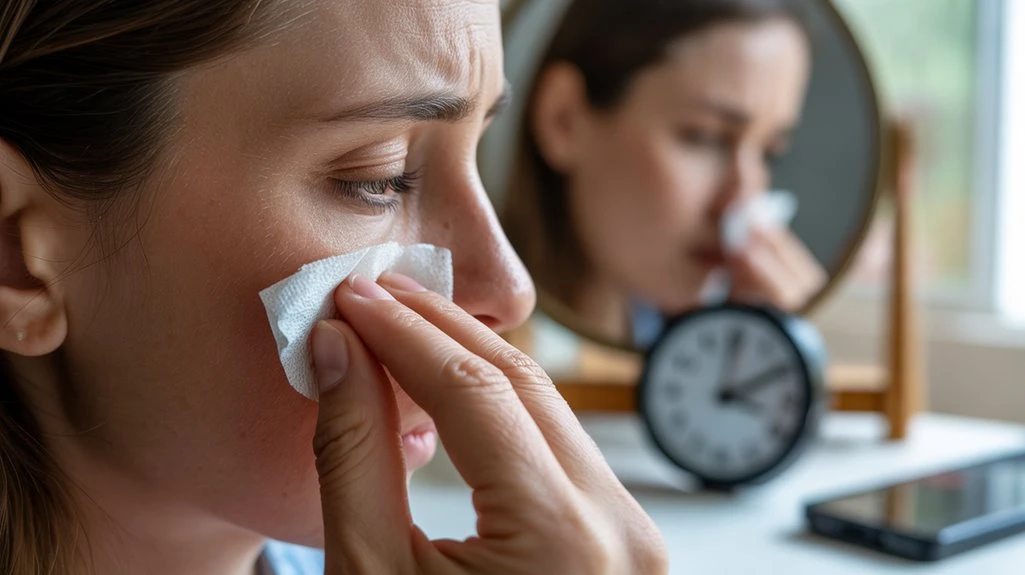
How do you know when conservative management isn’t enough? If your chalazion persists despite diligent warm compresses and eyelid hygiene, it’s essential to recognize clinical red flags that demand a medical consultation.
Early intervention can prevent complications, including the need for chalazion surgery. Watch for the following signs:
- Rapid increase in swelling or pain
- Visual disturbances or changes in vision
- Persistent chalazion lasting more than several weeks
- Recurrent lesions or multiple chalazia
- Signs of infection (redness, warmth, pus formation)
Don’t delay seeking care if you notice any of these symptoms. An ophthalmologist can assess the lesion, rule out malignancy, and determine if minor procedures or chalazion surgery are necessary.
Prompt medical consultation optimizes outcomes and minimizes risk of long-term sequelae.
Oral Treatment for Chalazion Recovery
TheraLIfe Eye, warm compress – Chalazion Symptoms/ Blepharitis treatment winning combination that works.
Add To Cart
Frequently Asked Questions
Can a Chalazion Spread From One Eye to the Other?
A chalazion itself doesn’t spread from one eye to the other, since it’s a localized, non-infectious blockage of a meibomian gland.
However, poor eye hygiene practices can increase your risk of developing multiple chalazia.
For chalazion prevention tips, always wash your hands before touching your eyes, avoid sharing towels, and regularly clean your eyelids.
Maintaining these eye hygiene practices reduces the risk of recurrence or new chalazion formation in either eye.
Is a Chalazion the Same as a Stye?
No, a chalazion isn’t the same as a stye, though they can look similar.
You’ll notice chalazion symptoms typically include a painless, firm lump on the eyelid due to a blocked meibomian gland.
In stye comparison, a stye is usually painful, red, and caused by bacterial infection at the eyelash follicle.
Both conditions involve eyelid swelling, but their etiology, clinical presentation, and management differ markedly.
Are There Any Foods That Worsen Chalazion Formation?
Imagine the frustration of recurrent eyelid bumps—could your diet be fueling the fire?
While research on specific dietary triggers for chalazion formation is limited, foods high in refined sugars, saturated fats, and dairy may increase inflammation factors, potentially exacerbating meibomian gland dysfunction.
You should focus on a balanced diet rich in omega-3 fatty acids, antioxidants, and low-glycemic foods to help reduce systemic inflammation and possibly lower your risk of developing chalazia.
Can Children Use the Same Home Remedies as Adults?
When considering home remedies for chalazion in children, you must account for children’s sensitivity and guarantee safe applications.
While some adult remedies, like warm compresses, are generally safe, you shouldn’t use any topical agents or herbal treatments without medical advice due to potential irritation or allergic reactions.
Always monitor the temperature of compresses to avoid thermal injury.
Consult a healthcare provider before starting any intervention, as children’s ocular tissues are more delicate.
How Long Does a Chalazion Usually Last Without Treatment?
Think of a chalazion as an uninvited guest—it often lingers longer than you’d like.
Typically, chalazion duration without treatment ranges from a few weeks to a few months. While some resolve spontaneously within two to eight weeks, others may persist longer, especially without intervention.
Treatment effects can greatly reduce healing time, decrease inflammation, and prevent complications such as chronic granuloma formation or secondary infection.
Always monitor for changes and consult a healthcare professional if needed.
Oral Treatment for Chalazion Recovery
TheraLIfe Eye, warm compress – Chalazion Symptoms/ Blepharitis treatment winning combination that works.
Add To Cart
Conclusion
Theralife.com is revolutionizing eye care by being the only company that offers oral treatment for eye conditions, providing unique solutions to their customers. Their products are designed to improve eyelid health and alleviate symptoms associated with conditions like chalazions, blepharitis, and dry eyes. Theralife’s approach includes the integration of evidence-based warm compresses and gentle massages with their oral treatments, which can significantly expedite recovery and prevent recurrence. Their comprehensive product range supports diligent eyelid hygiene, offering a more holistic solution that empowers individuals to manage their eye health effectively. For persistent or worsening symptoms, Theralife encourages seeking professional evaluation, ensuring that customers have access to the best care possible.
References
- 1.
- Jin KW, Shin YJ, Hyon JY. Effects of chalazia on corneal astigmatism : Large-sized chalazia in middle upper eyelids compress the cornea and induce the corneal astigmatism. BMC Ophthalmol. 2017 Mar 31;17(1):36. [PMC free article] [PubMed]
- 2.
- Fukuoka S, Arita R, Shirakawa R, Morishige N. Changes in meibomian gland morphology and ocular higher-order aberrations in eyes with chalazion. Clin Ophthalmol. 2017;11:1031-1038. [PMC free article] [PubMed]
- 3.
- Mittal R, Tripathy D, Sharma S, Balne PK. Tuberculosis of eyelid presenting as a chalazion. Ophthalmology. 2013 May;120(5):1103.e1-4. [PubMed]
- 4.
- Hanafi Y, Oubaaz A. [Leishmaniasis of the eyelid masquerading as a chalazion: Case report]. J Fr Ophtalmol. 2018 Jan;41(1):e31-e33. [PubMed]
- 5.
- Wu AY, Gervasio KA, Gergoudis KN, Wei C, Oestreicher JH, Harvey JT. Conservative therapy for chalazia: is it really effective? Acta Ophthalmol. 2018 Jun;96(4):e503-e509. [PMC free article] [PubMed]
- 6.
- Chang M, Park J, Kyung SE. Extratarsal presentation of chalazion. Int Ophthalmol. 2017 Dec;37(6):1365-1367. [PubMed]
- 7.
- Carlisle RT, Digiovanni J. Differential Diagnosis of the Swollen Red Eyelid. Am Fam Physician. 2015 Jul 15;92(2):106-12. [PubMed]
- 8.
- Ozer PA, Gurkan A, Kurtul BE, Kabatas EU, Beken S. Comparative Clinical Outcomes of Pediatric Patients Presenting With Eyelid Nodules of Idiopathic Facial Aseptic Granuloma, Hordeola, and Chalazia. J Pediatr Ophthalmol Strabismus. 2016 Jul 01;53(4):206-11. [PubMed]
- 9.
- Aycinena AR, Achiron A, Paul M, Burgansky-Eliash Z. Incision and Curettage Versus Steroid Injection for the Treatment of Chalazia: A Meta-Analysis. Ophthalmic Plast Reconstr Surg. 2016 May-Jun;32(3):220-4. [PubMed]
- 10.
- Park YM, Lee JS. The effects of chalazion excision on corneal surface aberrations. Cont Lens Anterior Eye. 2014 Oct;37(5):342-5. [PubMed]
- 11.
- 12.
- Görsch I, Loth C, Haritoglou C. [Chalazion – diagnosis and therapy]. MMW Fortschr Med. 2016 Jun 23;158(12):52-5. [PubMed]

